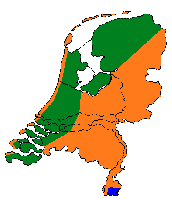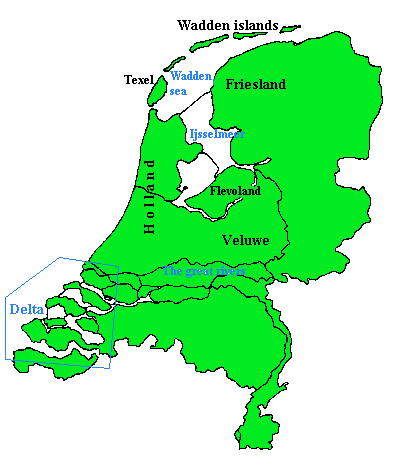Main Birding Areas in Holland
Geography
 The main geographical features of the Netherlands are as follows.
The main geographical features of the Netherlands are as follows.
The country divides into two major areas, which have very different vegetation and significant differences in avifauna:
- The north-western half consists of an area of clay, which after centuries of drainage has gradually sunk and is mostly below sea-level. This includes the provinces of Zeeland, Holland, Friesland, Groningen and the recently reclaimed land of Flevoland. This region includes a lot of wetland areas.
- The south-eastern half is sand, with some low hills formed by ice-age glaciers, and was originally a mixture of woodland, heathland and lowland moor.
Along the coast is a line of sand dunes, varying in width from a few hundred metres to about seven kilometres. In the north and south the sea broke through many centuries ago, creating large areas of islands and shallow sea. Land reclamation has meant that the islands in the south have grown considerably in area.
In the extreme south-eastern corner of the country is a small area of chalk hills rising to 300 metres above sea-level. This is in effect the northernmost tip of the Ardennes, although it is not usually referred to as such.
Birding Areas
The major birding areas in the Netherlands are as follows.
The Wadden
This area (pronounced Vodden) consists of a very shallow sea, much of which is exposed mud-bank at low tide, with a fringe of islands. All the islands are good for birds, but Texel (pronounced either Tessel or Texel) is probably the best. They are generally known in English as the Friesian islands, though in fact Texel belongs to Holland, not Friesland. This is one of the most important areas in Europe for birds.

Friesland
Friesland, and the immediately bordering area of Overijssel, is known for its wetlands. Apart from the breeding birds, south-west Friesland in particular is known as a major area for over-wintering geese. The Lauwersmeer, on the coast at the border between the provinces of Friesland and Groningen, is another important area.
Ijsselmeer
The Ijsselmeer (pronounced ICE-el-meer) is a huge area of fresh water. Although there is a great deal of disturbance from the fishing industry, it is still an important area for many species, such as wintering Smew and Goosander.Flevoland
Flevoland (pronounced FLAY-voe-lant) is a large area of reclaimed land, only completed in the late 1960's. In the beginning, while the land was drying out, this was effectively one enormous nature reserve. Much of it has now been taken over by agriculture or towns (which was, after all, the reason for the reclamation). However one area refused to dry out, and it now contains two of the most important wetland reserves in the Netherlands: the Oostvaardersplassen and the Lepelaarsplassen. Also the woods are surprisingly rich (for such young woods), at least in some species.
Veluwe
In the centre of the country is a large area of woodland and heathland, called the Veluwe (pronounced FAY-loo-uh). Large areas of this are national parks or other forms of nature reserve, and it is the most important area in the country for several species, such as Black Woodpecker, Wood Warbler, Firecrest and Pied Flycatcher.
The Delta
In the south-west of the country the distributaries of the Rhine and Maas (Meuse) form a series of islands. This is a very rich area of wetlands, with a few small areas of woodland.
This area is dominated by the Delta Works. This immense flood-control scheme was started as a result of the catastrophic floods in February 1953, which killed nearly 2000 people. Everywhere in the Delta you encounter huge dams, dykes, locks and sluice-gates. The effect on the wildlife has been mixed: good for some species and bad for others.
|
Next page: Speciality birds NL birding main page |
Last modified: 28/9/2011 |
